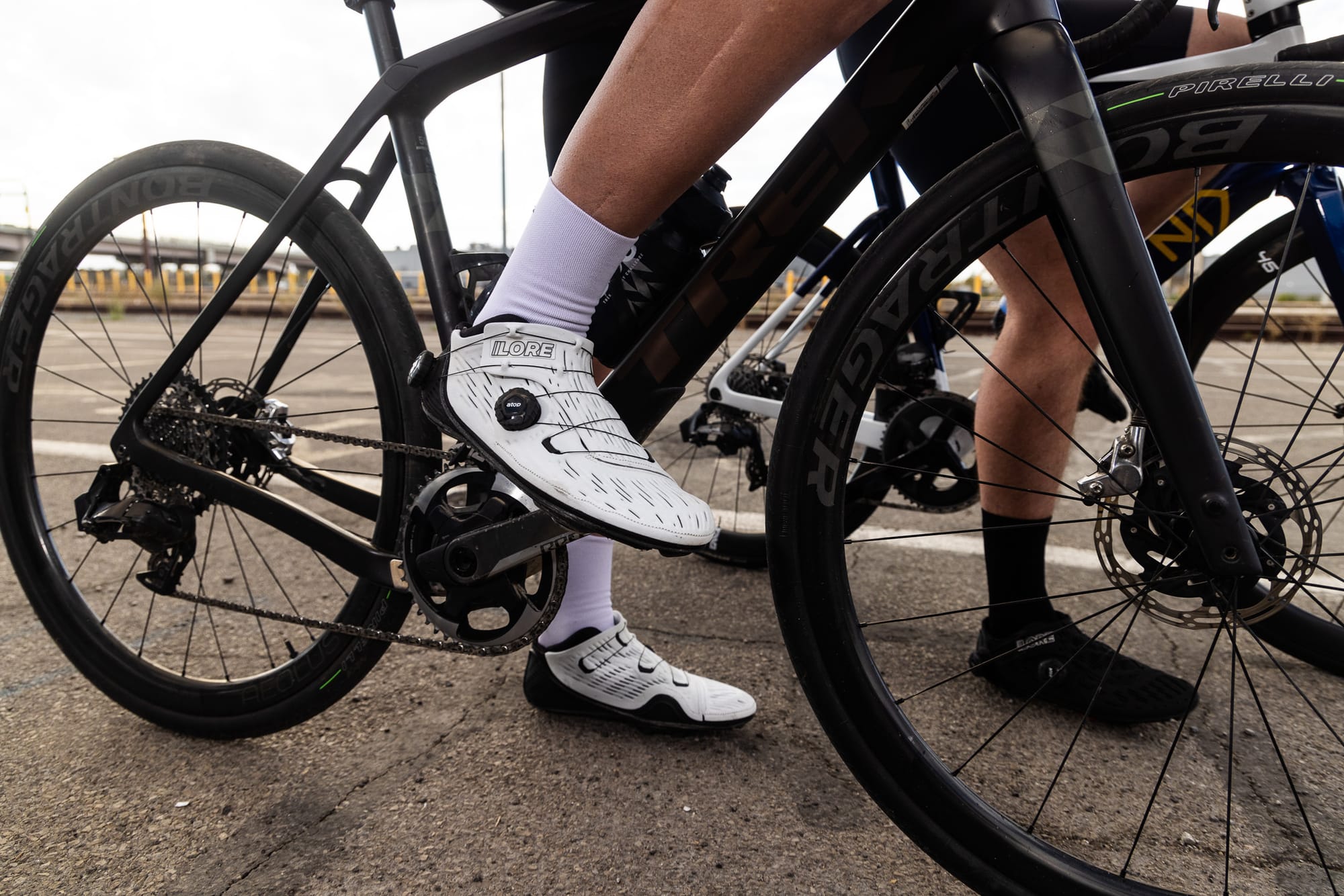Electric tyre inflators were once the prized possession of a rare few cyclocross race mechanics and home tinkerers. Fast forward a decade and these buzzy handheld inflators are now heard throughout the pits of road and mountain bike races, as well as at the local trailhead. And in just a few short years, we’ve seen them become available from just about every powertool-maker, a handful of generic brands, and some cycling brands, too.
Almost all of these electric inflators are designed with universal usage in mind, from inflating a car tyre to topping up a football. The one exception has been the inflators from Australian company Fumpa, which has been offering bicycle-specific inflators since 2017. Fumpa’s pumps have deviated from others with their more compact size, faster inflation, and a direct press-on fit with Presta valves. Following that initial product offering, Fumpa has since released two further and progressively smaller models that aim to replace a mini pump and/or CO2 inflator.
It was only a matter of time before Fumpa created enough demand for its bicycle-specific and pocket-sized electric inflator pumps that competitors would join the fray. And that’s exactly the story with the new Cycplus Cube, a new miniature inflator launched via a crowdfunding campaign on Indiegogo. At roughly the size of a box of matches (medium size), this new inflator takes undeniable inspiration (some elements are a straight copy) from Fumpa’s most compact and easily carried model, the NanoFumpa.
I’ve been testing these two pumps back-to-back for a few months, firstly to see which one is best, and secondly to figure out if either is a product I’d choose to carry instead of a CO2 inflator or mini pump.
Shared features and minimal sizing
A quick glance at the NanoFumpa and Cycplus Cube will have you thinking these are vastly different products, and that’s certainly true from an aesthetic point of view. However, the similarities are undeniable once you look at the functionality.
Both of these inflators were designed, first and foremost, as ultra-compact emergency pumps to replace a mini pump or CO2 inflator. Merely push them onto a valve, press a button, and let the mini electric motor do all the hard work. Using one of these means you get time-efficient tyre inflation without the usual arm fatigue, bent valve stems, or accidental release of compressed CO2.

The Cycplus and Fumpa can be configured to work with Presta or Schrader valves by removing or including a small brass insert. Both offer USB-C charging, which happens in less than an hour given the small battery capacity, and both include a USB-C cable for said charging.
The two units are also similar in what they lack. Neither comes with any claimed water resistance, and Fumpa even includes a matching ziplok bag as a result. Meanwhile, both of these cutely sized items lack a pressure gauge – a handy feature found on larger inflators from both companies.
Compact sizing matters a lot given that these inflators are designed to be carried on a ride. The NanoFumpa is marginally smaller in length at 58 mm, but its external valve head adds noticeable height. By contrast, the 65 mm-long Cycplus Cube hides the valve head within its body, and as such, has a larger external volume that surprisingly feels more compact in use.
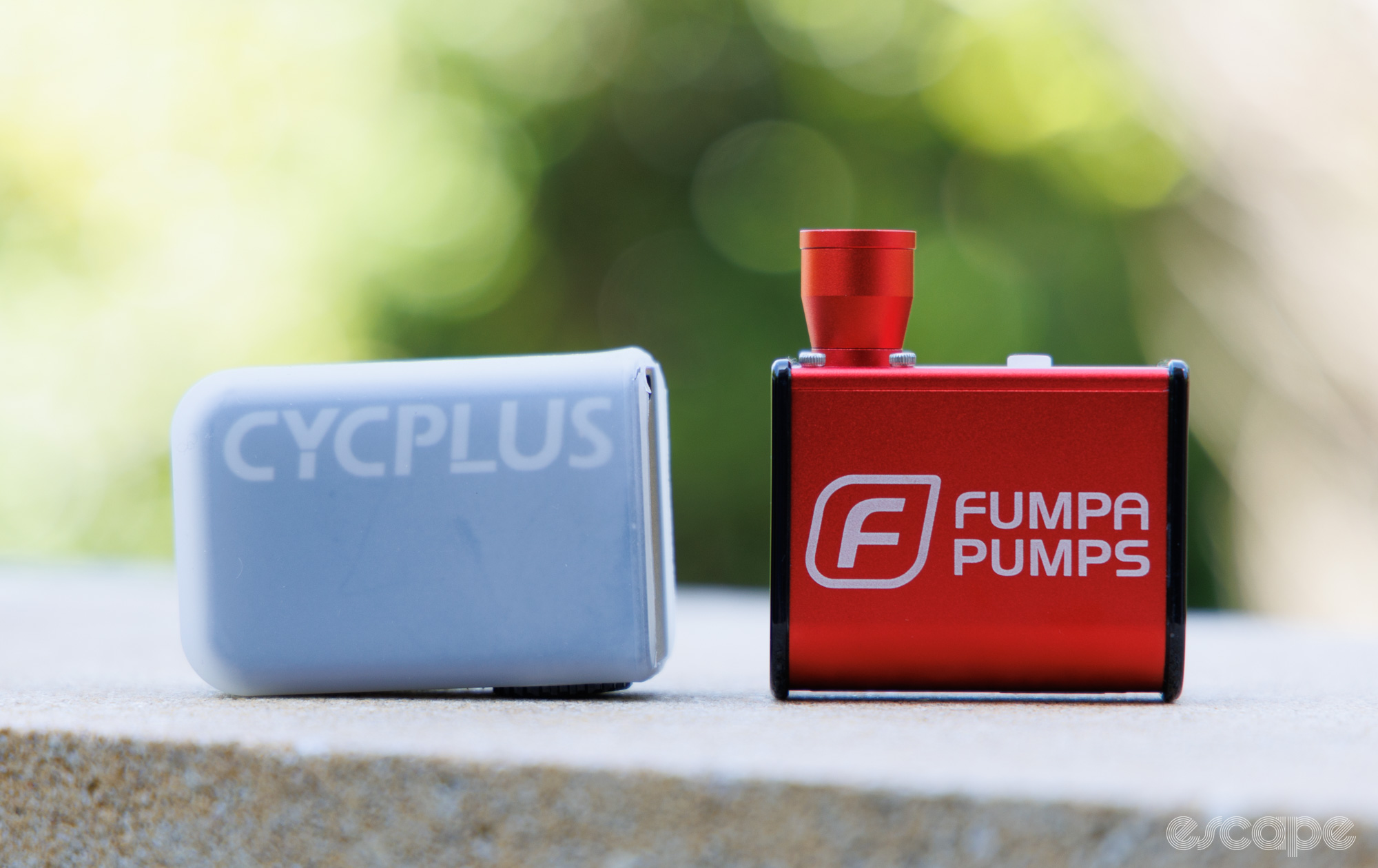
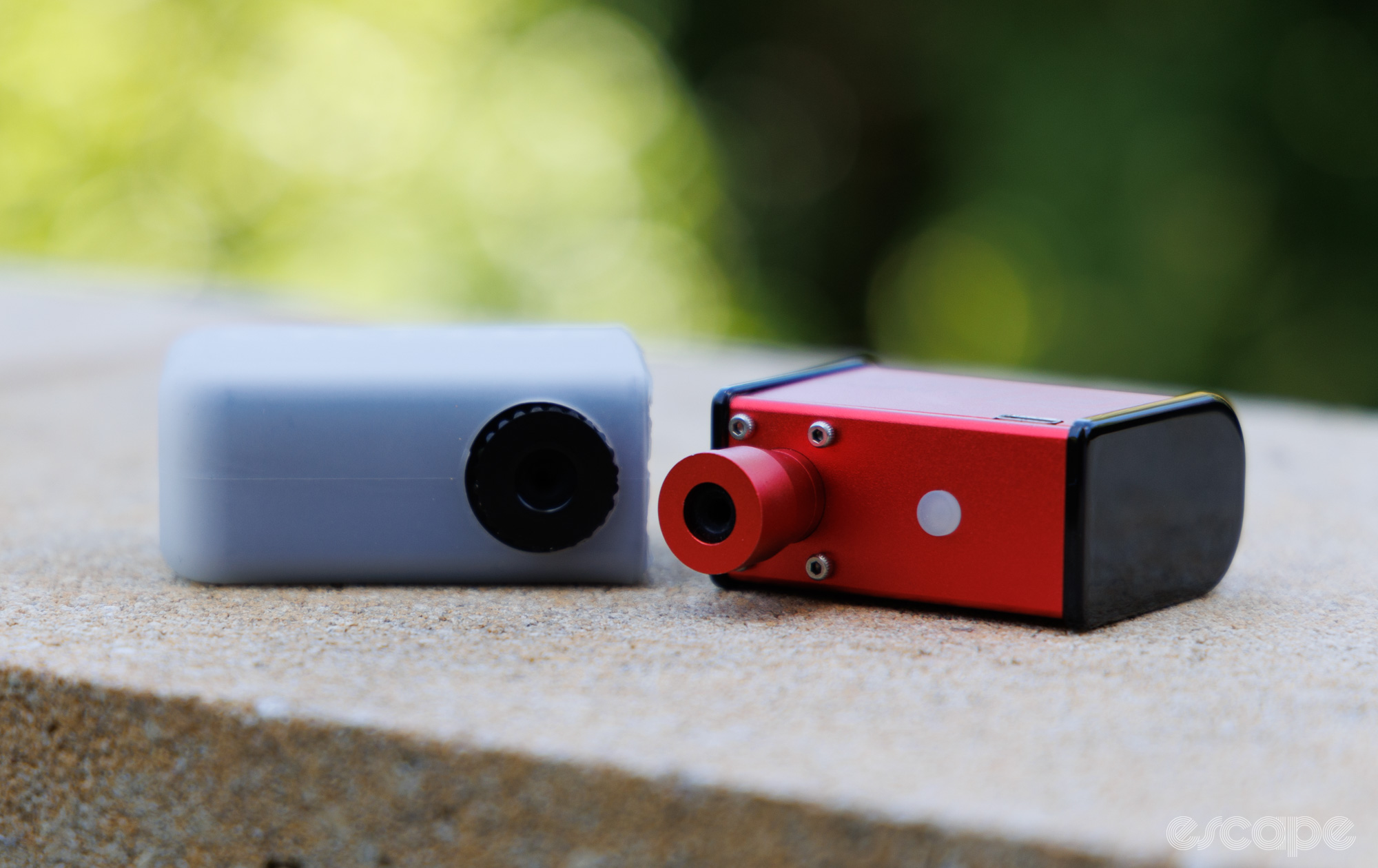
The NanoFumpa wins on the scales at 97 g, while the Cycplus Cube is only marginally heavier at 102 g (120 g with its included silicon cover). By comparison, a fairly common CO2 inflator head and two 16 g CO2 cartridges weigh a combined 128 g.
From a build quality sense, both the Fumpa and Cycplus use an aluminium body. The Fumpa varies this with plastic side panels which provide a cooler place for you to grip the unit; a feature shared with its larger cousins. A look inside reveals similar technology, but the Fumpa seems ever-so-slightly more robust with the brushless motor secured to the body with stainless bolts and the battery better protected and with more internal breathing room.
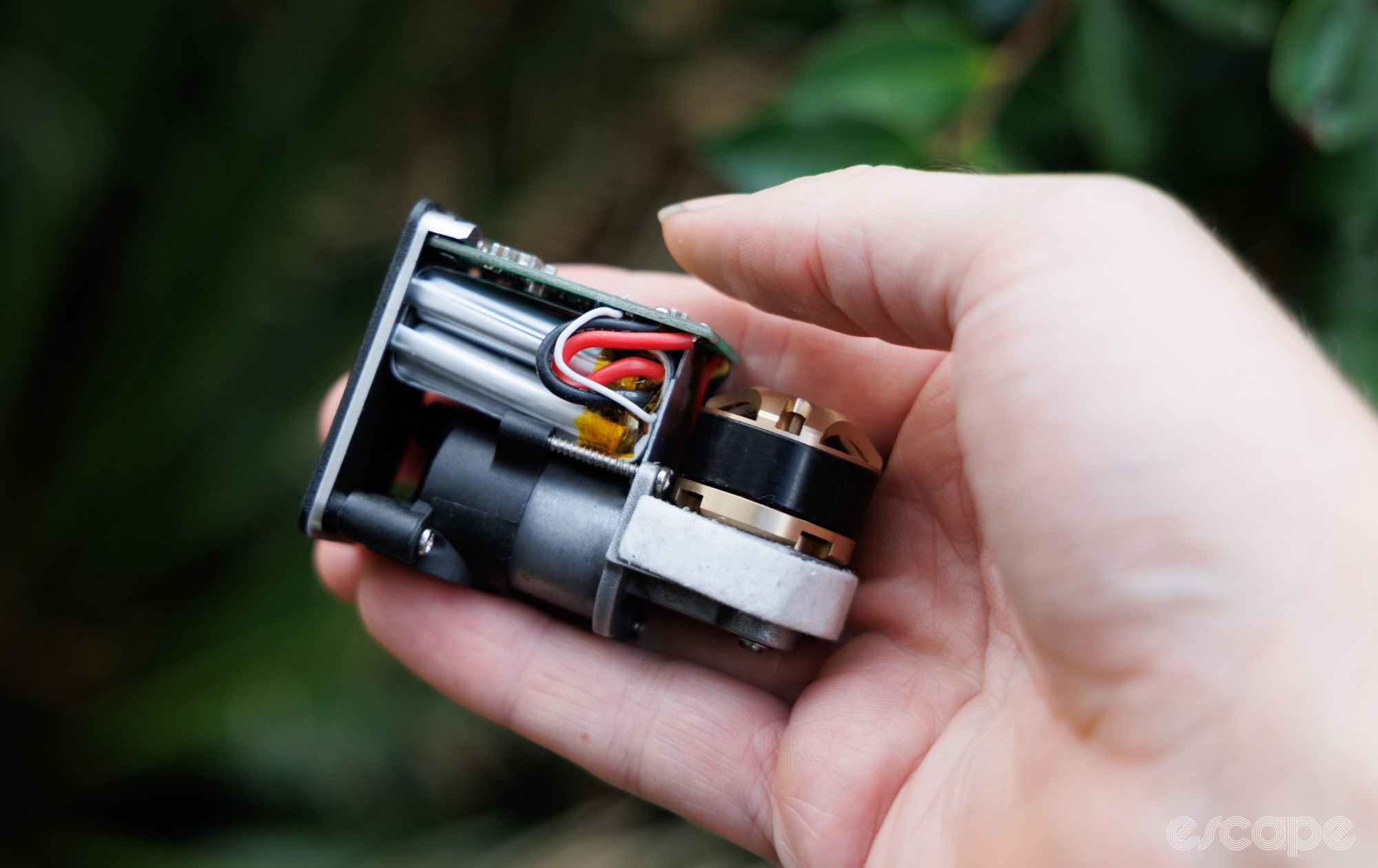
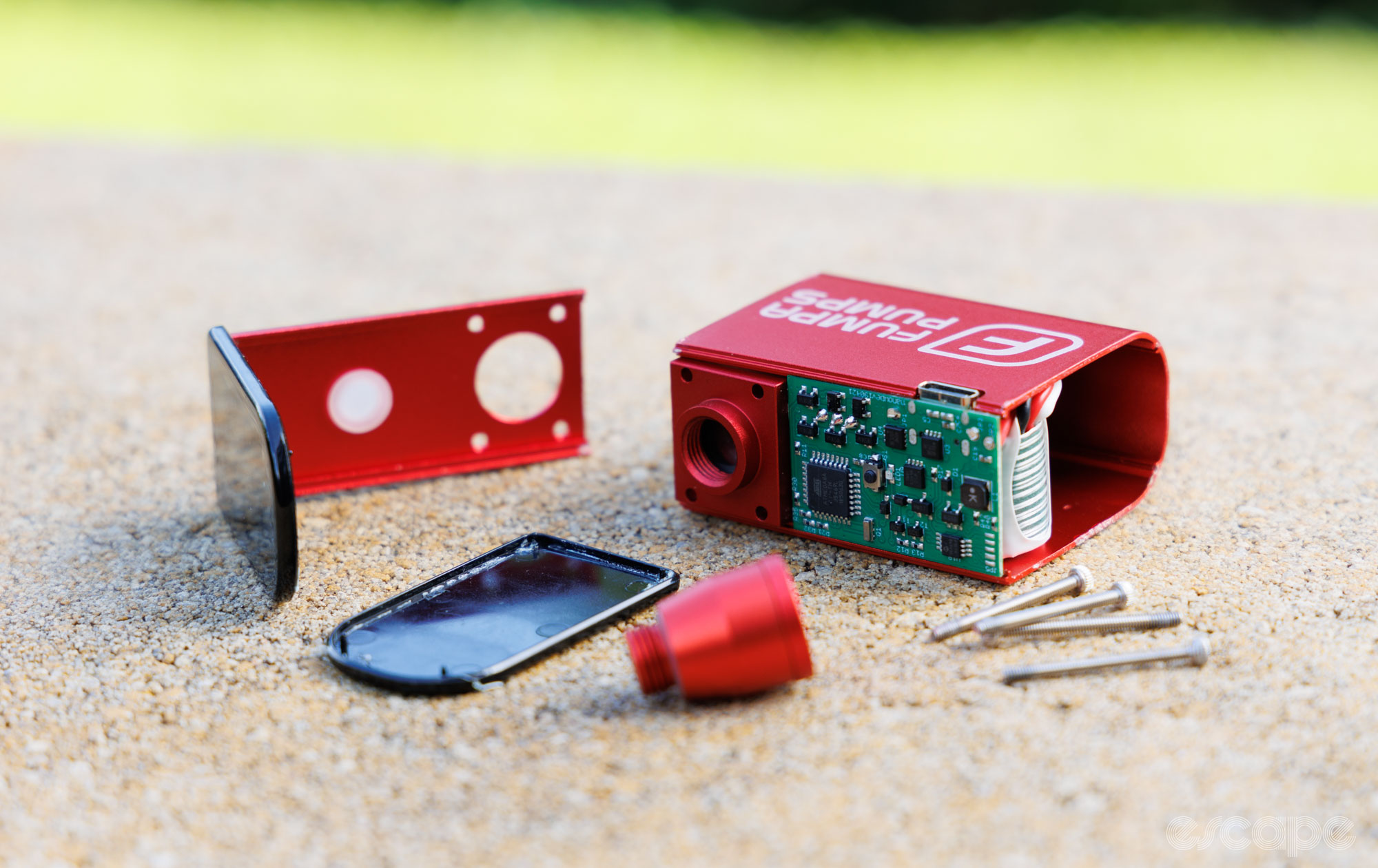
Travelling with either of these devices is no problem, and most airlines won’t have a problem with you packing them as either carry-on or checked baggage.
The NanoFumpa is assembled in Australia (from parts likely manufactured in China) and sells for US$99 / AU$119. Priced at US$89 / AU$134, the Cycplus Cube is manufactured in China. Both brands offer free shipping within major markets.
Pumping speeds vs longevity
According to Fumpa, the NanoFumpa is only designed to fill a single tyre, or top-up the pressures on two tyres. Thankfully I found both of these pumps far more capable than that. I ran multiple tests, and consistently the NanoFumpa lasted the longest off a single charge.
Before I share the specifics of my testing, it’s worth noting that in response to the Cycplus, Fumpa recently tweaked a few of the electronic settings in its Nano model to offer faster tyre inflation and higher maximum pressure (now 110 psi up from 80 psi). These updates only occurred a few weeks prior to publishing this review, and thankfully I was able to redo my testing with the updated model.
For road riding, I tested the pumps on a 700 x 28 mm tyre (28 mm claimed and measured width) inflated to 80 psi. I chose 80 psi as that is a fairly common pressure for modern-width road tyres, and it’s around this point that most high-pressure mini pumps begin to struggle.
The NanoFumpa achieved the first road tyre inflation in 1 minute, 40 seconds. It then successfully filled a second tyre from 0 to 80 psi. The NanoFumpa switched off from a flat battery upon reaching 48 psi on the third inflation. By comparison, the Cycplus Cube filled the first tyre to 80 psi in 1 minute, 45 seconds. It was then only able to fill the second tyre to 77 psi before the battery was flat.
For gravel testing, I used a 700 x 40 mm tyre on a 25 mm internal width rim (42 mm measured width), inflated to a relatively high pressure of 40 psi. The NanoFumpa achieved the first inflation in 1 minute, 36 seconds, successfully filled a second tyre to 40 psi, and then cut out at 37 psi on third inflation – very impressive. The Cycplus Cube filled the first tyre in 1 minute, 33 seconds, successfully filled a second tyre, and cut out at 21 psi on the third inflation.
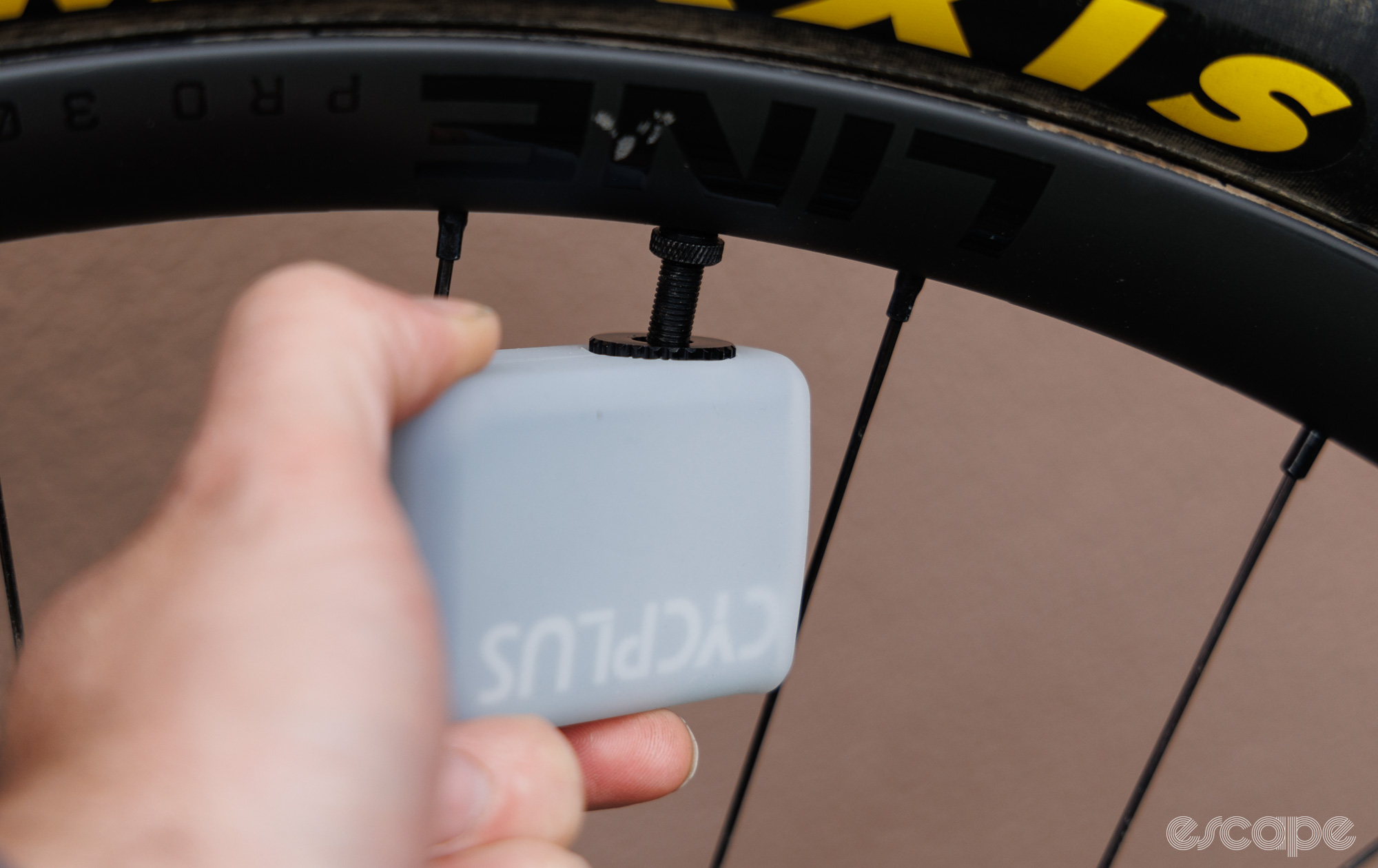
Lastly, for mountain bike testing, I used a 29 x 2.35" tyre on a 30 mm internal width rim with a goal pressure of 25 psi. The NanoFumpa achieved the first inflation in 2 minutes, 5 seconds. Impressively, it then filled a second tyre, and got a third inflation to 17 psi. The Cycplus Cube filled the first tyre in just 1 minute 48 seconds, it successfully hit 25 psi on the second inflation, but went to sleep at only 6 psi on the third inflation. As a side note, the original and noticeably larger original Fumpa pump filled this same mountain bike tyre in 42 seconds and can repeat that action multiple times over.
What this testing showed is that off a single charge, both the NanoFumpa and Cycplus Cube will comfortably produce a volume that’s comparable to or even bests the use of two 16 g CO2 cartridges. The testing also showed that higher pressures strain battery longevity more than absolute volume output. To this point, while the NanoFumpa and Cycplus Cube were able to reach actual maximum pressures of 109 psi and 99 psi, respectively, such loads brought excessive heat and obvious battery drain. If you want a pocket-sized electric inflator that comfortably exceeds 80 psi then check out the marginally larger MiniFumpa.
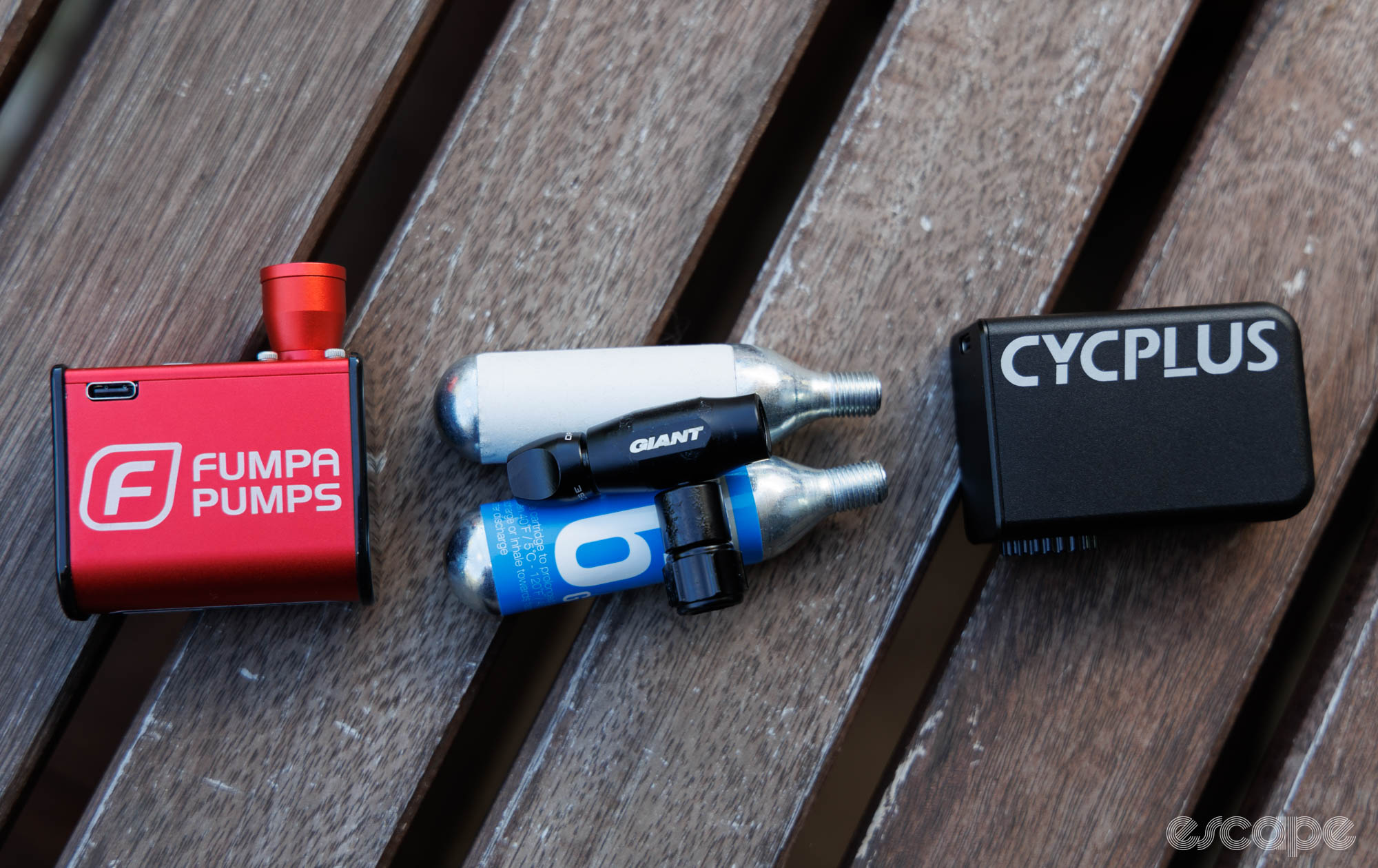
If we're looking at the inflation times, it’s important to note that the NanoFumpa has a timing feature that turns itself off after 50 seconds of inflation (the Cycplus Cube has no such feature). This predominantly exists in case the pump accidentally turns itself on while inside a bag, but according to Fumpa, the feature also serves as a rough guideline for tyre pressure. For example, at 50 seconds, a road tyre will be approximately pumped to 50 psi, while a 40 mm gravel tyre will get to roughly 25 psi. Doing a long press on the button gets the pump started again, and the delay this caused is included in the times quoted above.
Using the things
Using either of these inflators is easier and more intuitive than any alternative CO2 or mini pump, at least once you have the pump head set up for the appropriate valve type. For the NanoFumpa, you merely press the inflator onto the valve, hold down the button for five seconds to turn it on, and away you go. The process is similar for the Cycplus Cube, although it switches on with three quick button presses. Both inflators will continue to run automatically until you press the button again. Similarly, neither pump has a secondary lock feature to prevent accidentally turning the unit on in the event the single button is inadvertently pressed or held in the right sequence.
Fumpa’s press-on valve head design is a good one, and requires little holding effort to maintain a reliable seal up to maximum pressure. This valve head works on threaded and threadless valves without issue, and won’t unwind your valve cores like a few popular mini pumps do. The only complaint is related to that small brass insert that's required for Schrader use – it's easy to lose and fiddly to swap with sweaty hands, so it's best to set up the pump for your desired valves and leave it that way. Given that Cycplus has copied Fumpa’s valve head design without fault, the same applies for them, too.
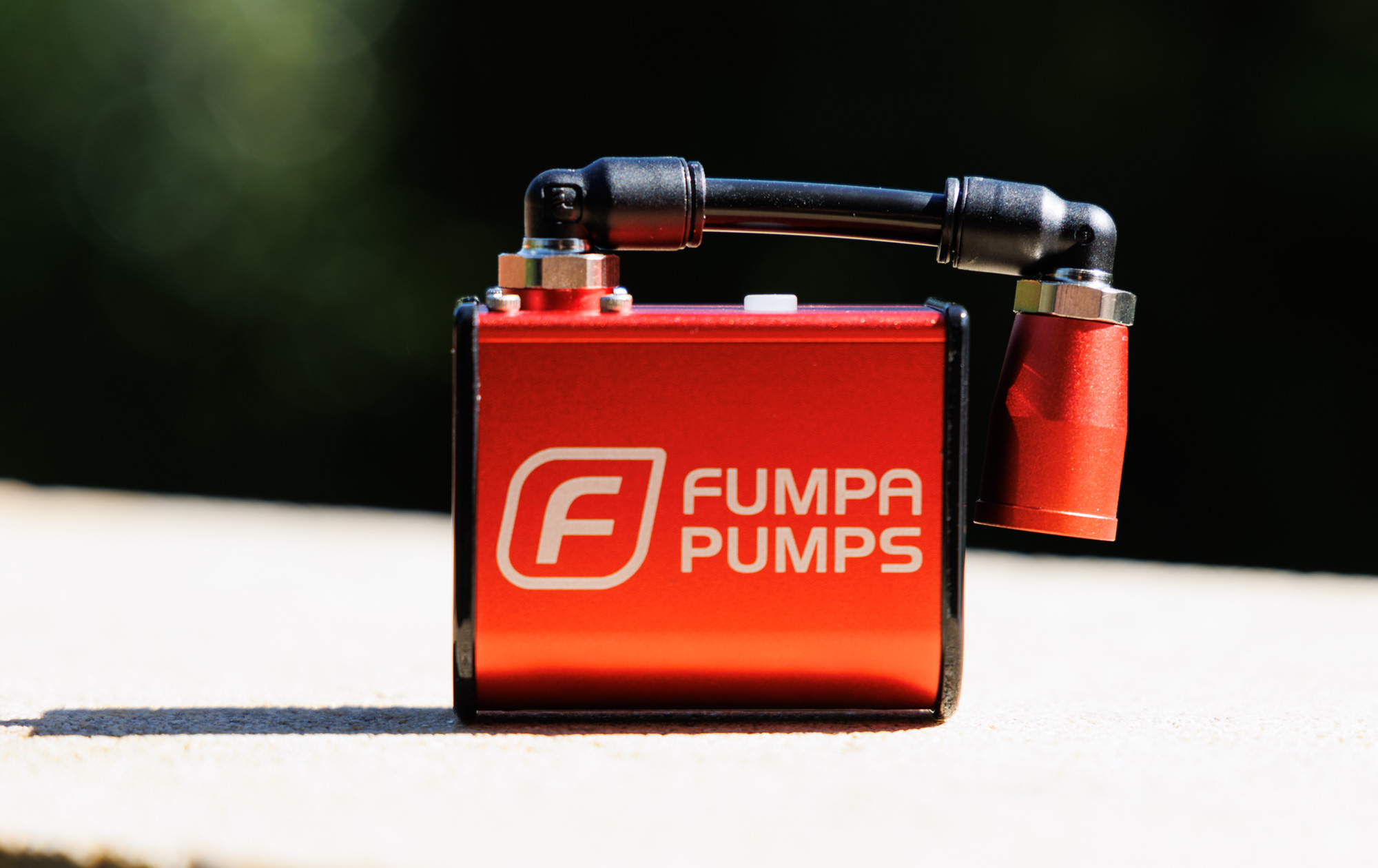
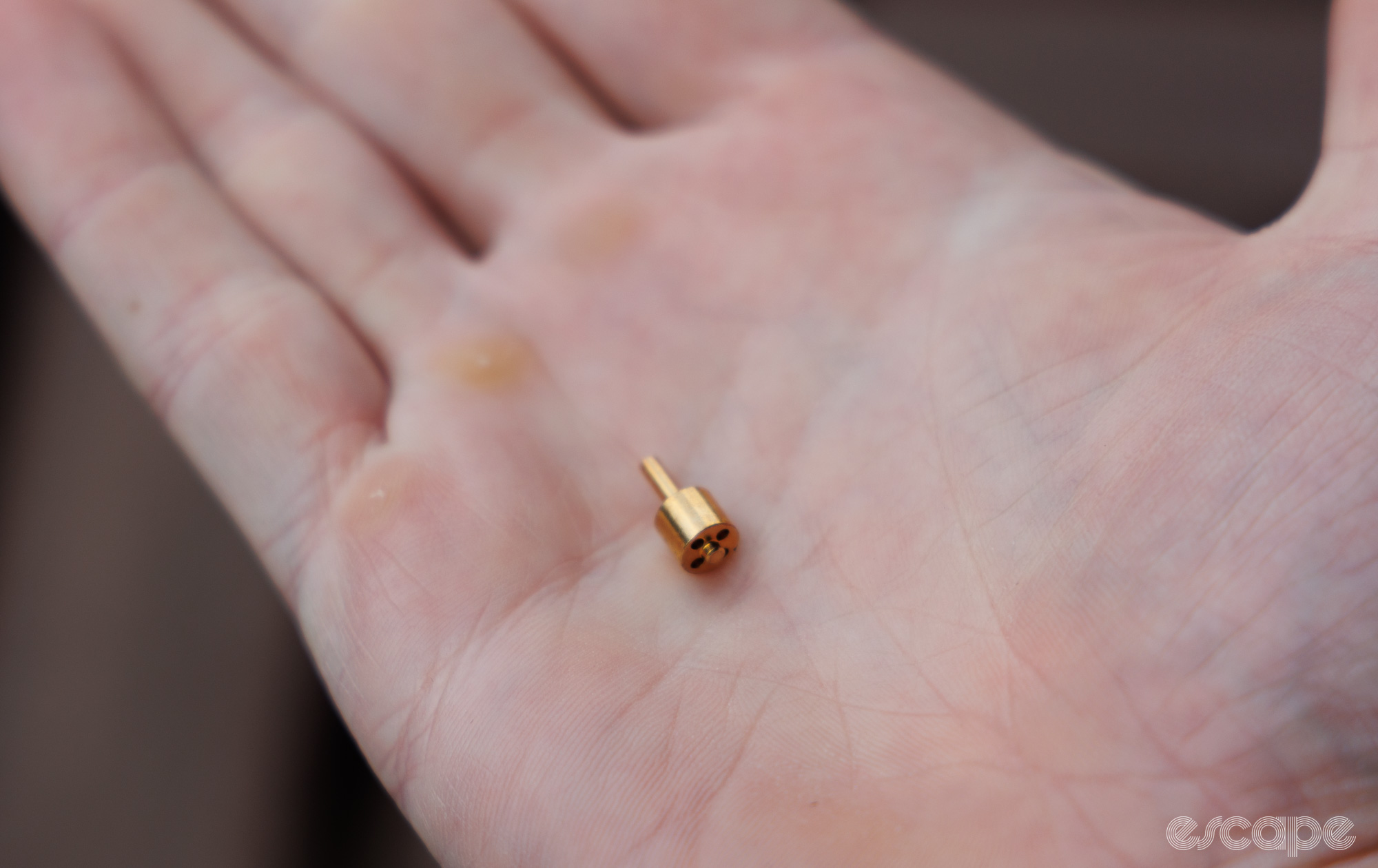
The one major caveat in using these pumps is that the Cycplus Cube will not get started on an already pressurised tyre – something I’m led to believe lets it circumnavigate Fumpa’s patent. To overcome this, you can turn on the Cube before connecting it to the valve. By contrast, the NanoFumpa works no matter how or when you connect it.
In use, the pumps generate a surprising amount of heat. I clocked both of them at 40 ºC (104 ºF) after filling a mountain bike tyre, and that temperature is significantly higher when stressing them to maximum pressure. The Cycplus and its full aluminium case was scarily hot to hold onto when stressed to its 99 psi turn-off point, while the Fumpa has those plastic sides that make gripping it a little more pleasant. Cycplus overcomes this with a silicon cover that keeps your hands shielded from the heat and damps vibration, but this cover also slows down the device’s ability to cool. Either way, using one of these is effectively an episode of Geek Warming (niche pun concerning Escape Collective’s tech podcast).
Both are noisy little buggers that are sure to attract unwanted attention from the local weirdo who still carries a traditional frame pump (I joke, of course). The NanoFumpa is noticeably more obnoxious and whiny in its sound. I measured the NanoFumpa and Cycplus Cube at 90 and 85 dB, respectively.
Being electronic devices with automatic battery health monitoring, you can expect the need to recharge these devices every couple of months due to battery drain. This is one of the most obvious drawbacks if you’re using one of these inflators in place of a mini pump or CO2 inflator where you may go months (or years) without needing it.
And let’s not forget that these devices aren’t water resistant. Fumpa’s provided zip-lock bag is a welcomed addition, and you’ll probably want to do something similar for the Cycplus to ward off any unexpected downpours or sweat that may find its way into the USB-C port (which doubles as the air inlet for the pump).

Am I a convert?
When it comes to home and travel usage, I’m wholly sold on the idea of an electric inflator, or more specifically, the original and full-sized Fumpa. The past few years have seen this standard Fumpa all but replace my use of a floor pump when topping up tyres and checking pressures before a ride. Part of that is because there’s minimal backfill (air loss) in connecting such an inflator. Another reason is that it is unbeatably quick and it has an accurate gauge. Clearly, I’m sold on the idea of an electric inflator (well, the Fumpa – other options still have me preferring a good floor pump), but that preference is all about convenience rather than being used at a time of necessity.
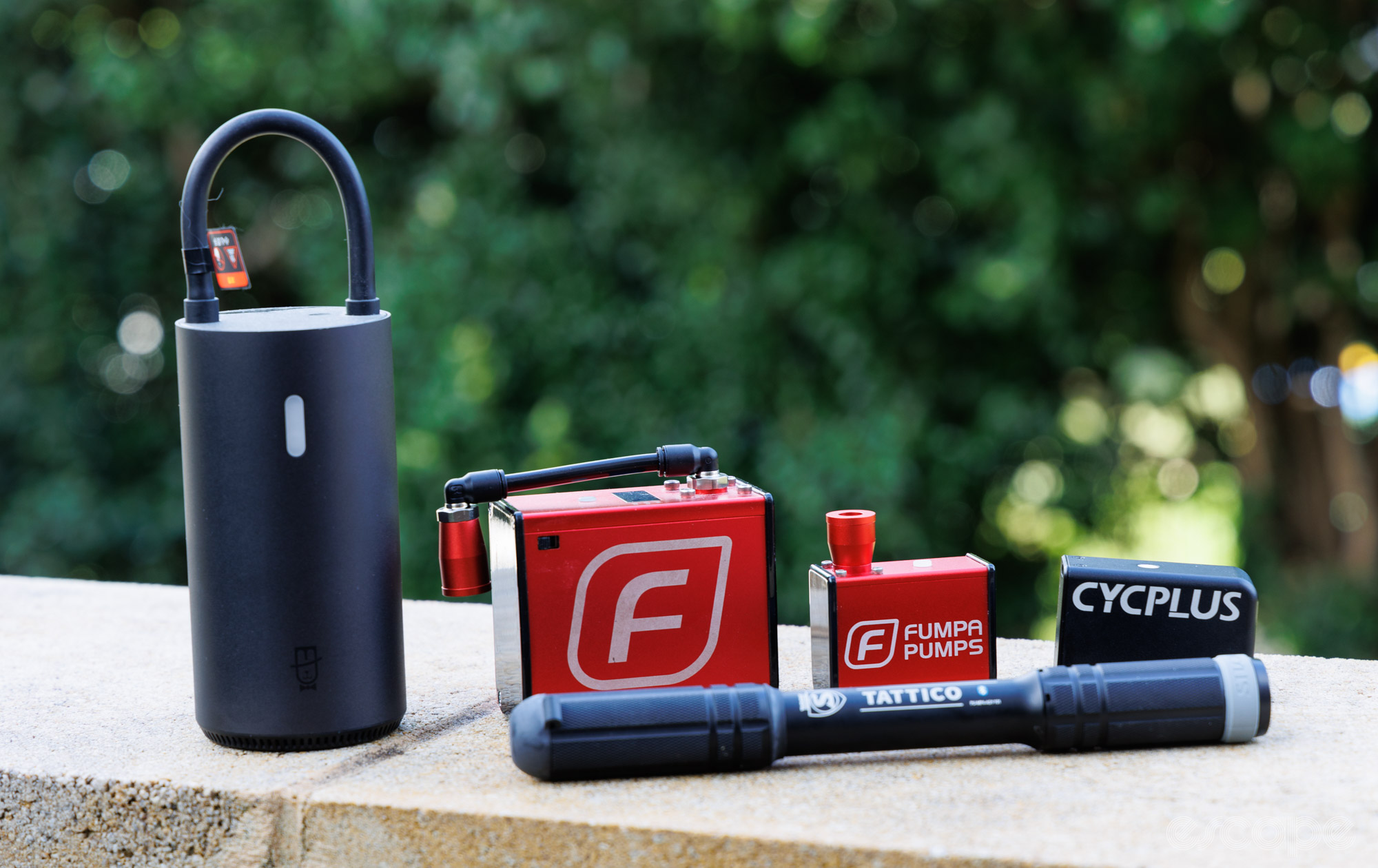
My opinion changes when talking about a pump designed to be used in case of emergency. If I’m at home and my Fumpa inflator has a flat battery, I can use another pump and head out. Such a luxury doesn’t exist if the electric inflator is all you have while stuck on the side of the road or deep down a trail. Here, I take comfort in knowing that in the rare (really rare) event I do flat, my CO2 inflator is waterproof and didn't require charging. Meanwhile, for longer and more remote rides where multiple flats are a possibility, then I’ll still be reaching for a trustworthy mini pump where my energy exertion is the only inflation limit.
So while there’s a lot I like about these products, it’s clear that I’m not fully sold on them as a road/trail-side solution. That said, judging by the sales of these things, there are hundreds, if not thousands, who disagree with me. So who do I think will like these?
Firstly I think of the person who regularly experiences flat tyres, perhaps in uncomfortably cold conditions and/or when others are waiting. The convenience of an electric inflator makes plenty of sense here, but I’d also suggest assessing why you get so many flats and trying to solve that problem first (clue: it’s your tyres).
Another use case for such cute little inflators is if you like being the hero of your riding group, where having such an inflator means you get to save the day and reduce your time standing in the cold when someone else flats. In this scenario, it'll take a lot of free coffee to get your return on investment, but you'll undoubtedly feel good about it.
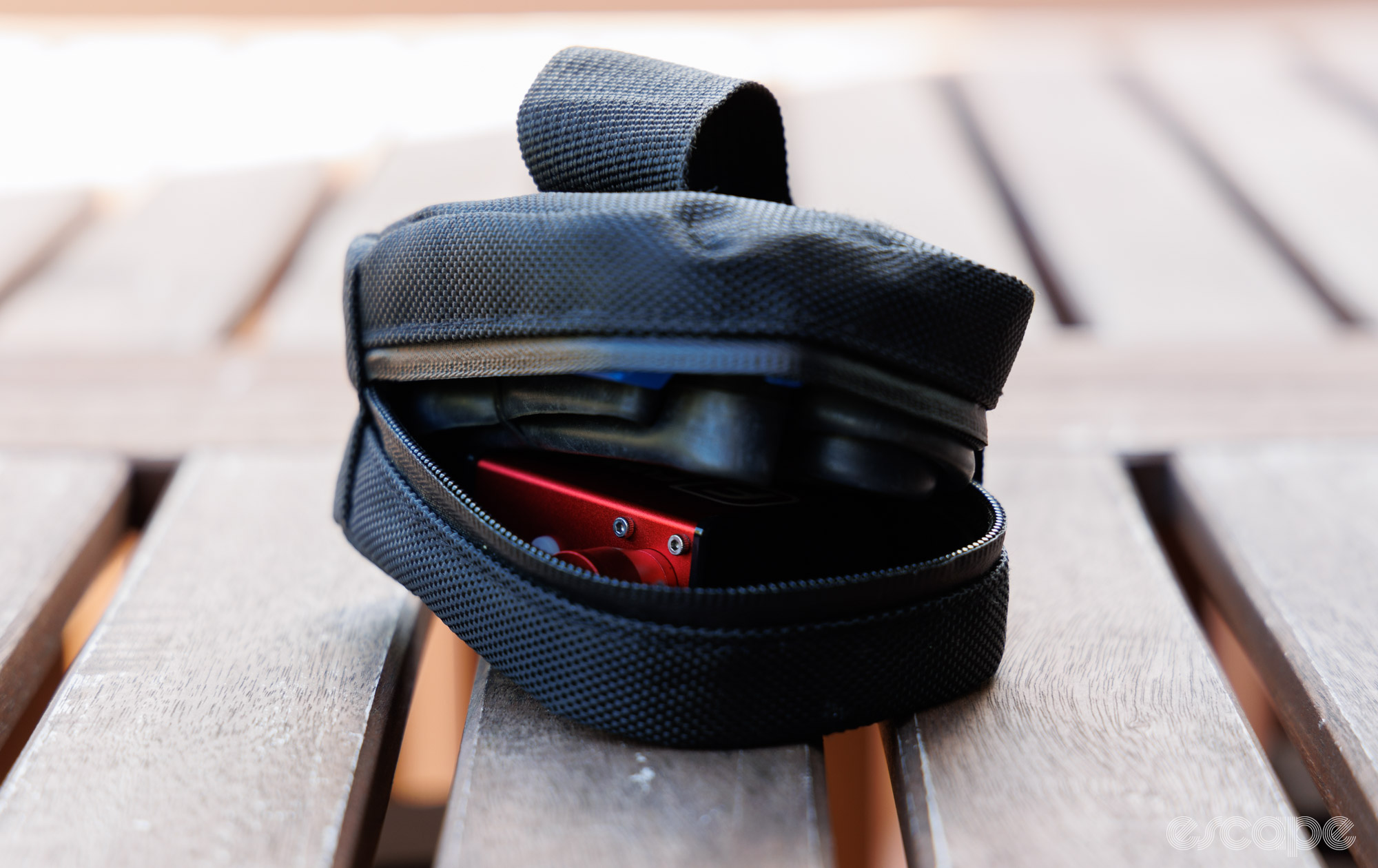
And finally, these little pumps are pretty well suited to casual riders and/or as a travel pump, where they could be used to inflate your tyres, be put on a brief charge, and then be taken with you as your emergency pump. In this scenario, you could always be sure about the battery state, while the minimal weight, size, and easy use would be hugely beneficial. Plus, travelling with CO2 cartridges is a no-no, so it overcomes that niche-but-common issue. Of course, you’ll probably want to add a small pressure gauge into your kit for pre-ride use, but this applies to most other portable hand pumps, too.
So, which one should you pick, assuming you’re sold on a matchbox-sized electric tyre inflator? It’s undoubtedly a close competition, but for me, it would be the NanoFumpa. Despite its less appealing form factor, it pumps out more air off a single charge, it’s marginally lighter, it gets bonus points for creating the concept and being assembled in-house, and all without a major price difference.
Did we do a good job with this story?



